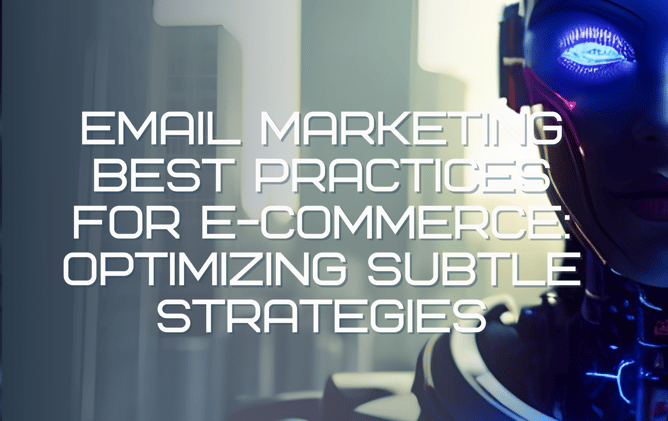Email Marketing Best Practices for E-commerce: Optimizing Subtle Strategies
Discover effective email marketing strategies for e-commerce businesses in this short blog post. Learn how to optimize subtle tactics that can significantly impact your campaign's success. From personalization and segmentation to engaging content and automation, these best practices will help you drive higher engagement and conversions.


Email Marketing Best Practices for E-commerce: Optimizing Subtle Strategies
Introduction
Email marketing remains one of the most powerful tools for e-commerce businesses to engage with customers and drive conversions. However, optimizing your email marketing strategies to stand out in crowded inboxes is essential with the increasing competition and evolving consumer expectations. This blog post will explore some best practices for email marketing in the e-commerce industry, focusing on subtle yet effective tactics that can significantly impact your campaign's success.
Key Points:
Personalization: Tailoring your emails to individual customers can significantly enhance their relevance and engagement. Collect data about your subscribers' preferences, past purchases, and browsing behavior to deliver personalized recommendations and offers.
Segmentation: Only treat some of your subscribers the same. Segment your email list based on demographics, purchase history, engagement level, or other relevant factors. It allows you to create targeted campaigns that resonate with specific customer groups.
Optimize Subject Lines: Your subject line is the first impression your email makes. Craft compelling subject lines that are concise, intriguing, and relevant. A/B testing different variations can help you identify the most compelling subject lines for higher open rates.
Responsive Design: With the rise of mobile usage, ensuring your emails are optimized for various devices is crucial. Use responsive design techniques to ensure your emails look great and function well on smartphones, tablets, and desktops.
Engaging Content: Create visually appealing and engaging email content that captivates your subscribers. Use high-quality images, concise and compelling copy, and clear calls-to-action (CTAs) to drive clicks and conversions.
Automation and Triggered Emails: Implement automated email campaigns triggered by specific customer actions, such as abandoned cart reminders, post-purchase follow-ups, or personalized recommendations based on browsing history. These timely and relevant emails can significantly improve customer engagement and sales.
A/B Testing: Continuously test different elements of your email campaigns, such as subject lines, CTAs, content layout, and visuals. This A/B testing allows you to identify what works best for your audience and optimize your emails accordingly.
Opt-in and Opt-out Processes: Ensure your email subscription process is user-friendly and transparent. Make it easy for customers to opt-in to receive your emails, and provide a transparent and hassle-free opt-out process if they wish to unsubscribe. Respecting subscribers' preferences builds trust and strengthens your relationship with them.
Questions and Answers:
Q: How often should I send emails to my subscribers?
A: The frequency of your email campaigns depends on your business and target audience. It's essential to balance staying top-of-mind and avoiding overwhelming your subscribers. Monitor engagement metrics and feedback to determine the optimal frequency of your emails.
Q: How can I improve email deliverability?
A: To enhance deliverability, maintain a clean and up-to-date email list, use double opt-ins to confirm subscribers' interest, avoid spam trigger words, optimize your email sending infrastructure, and adhere to email marketing best practices.
Q: What metrics should I track to measure the success of my email campaigns?
A: Key metrics to monitor include open rates, click-through rates (CTRs), conversion rates, bounce rates, unsubscribe rates, and overall ROI. Analyzing these metrics helps you gauge your campaigns' effectiveness and identify improvement areas.
References:
conclusion
Email marketing is vital for e-commerce businesses to connect with customers and drive revenue. When implementing the best practices discussed in this blog post, you can optimize your email campaigns for better engagement, conversion, and customer loyalty.
Personalization and segmentation allow you to deliver tailored messages that resonate with your audience.
Crafting compelling subject lines, designing responsive emails, and creating engaging content will capture your subscribers' attention and drive them to take action. Leveraging automation and triggered emails will help you deliver timely and relevant messages, enhancing customer engagement.
Remember to continuously analyze and refine your email campaigns through A/B testing and monitoring key metrics. By understanding your audience's preferences and behavior, you can make data-driven decisions to improve the effectiveness of your emails.
For further guidance and insights, refer to the recommended resources in this blog post. By staying informed and adopting these email marketing best practices, you can optimize your e-commerce email campaigns and achieve remarkable results.
Start implementing these strategies today and unlock the full potential of email marketing for your e-commerce business.


